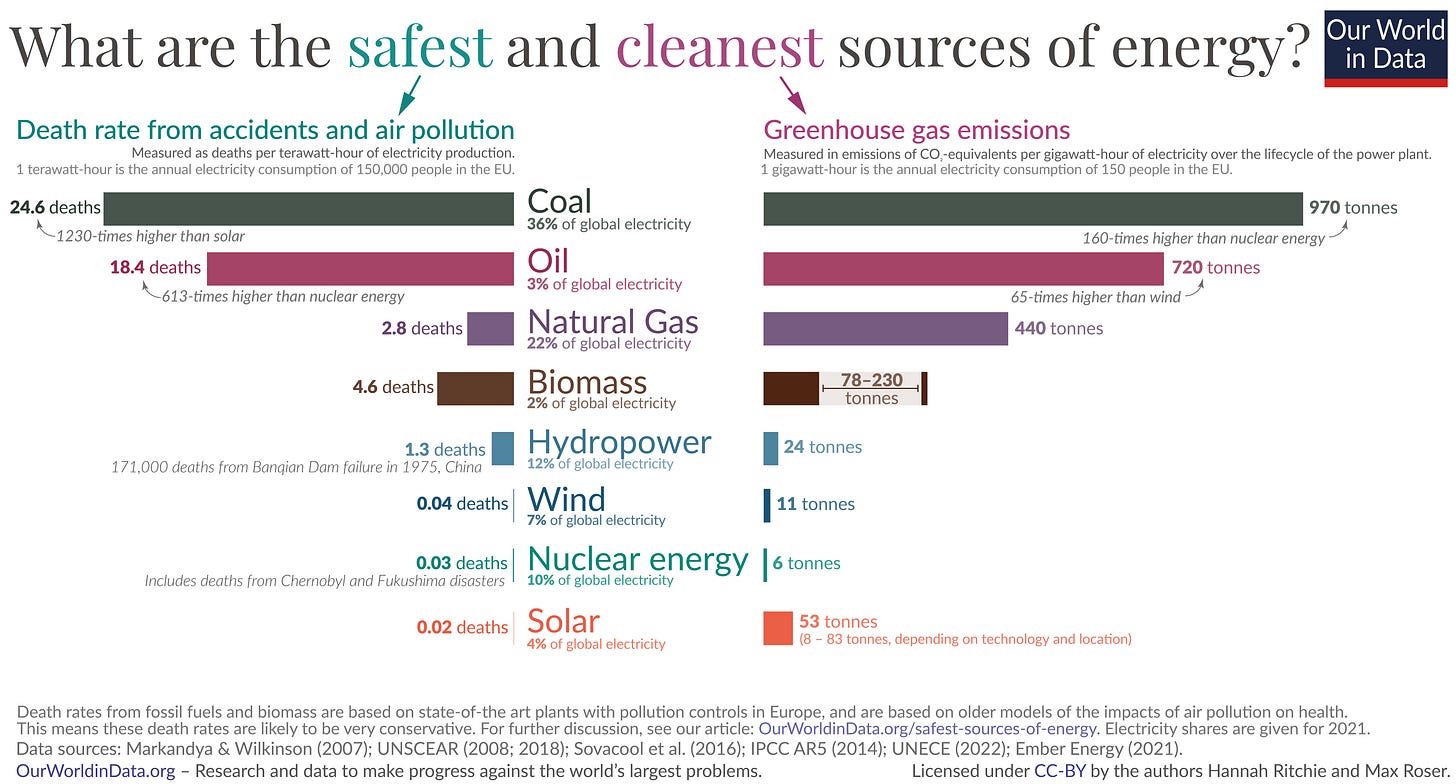#23 Can Nuclear energy save the planet?
Nuclear is a clean, safe and reliable source of energy. In a power-hungry world that needs to de-carbonize, can nuclear be the solution we all need?
Welcome to 3X, the publication about living a meaningful life, read by 3000 people every week
A Clean Energy Source for a Power-Hungry World
Today, fossil fuels still account for 80% of global energy consumption. In a world that is expected to demand 50% more energy by 2025, the challenge is more than served.
In this context, nuclear energy—a consistent, low-carbon, safe and reliable power source—should be an indispensable part of the solution.
Yet, that’s not the case. Nuclear’s share in the global energy mix has strongly decreased over the last 25 years (from 7% in 2000 to 4% today).
So the question is obvious: What is the role of nuclear energy in a Net Zero world? Do the challenges of scaling nuclear outweigh its obvious benefits?
Three Manageable Challenges
Nuclear detractors tend to pose 3 challenges. Let’s see if they hold.
1. Nuclear is high cost and slow to build
Compared to renewables, nuclear energy remains expensive ($60–120 per MWh, versus $30–50 per MWh for solar and wind). Additionally, traditional nuclear power plants take 10–15 years to build—far longer than the 1–3 years required for solar or wind projects.
However, there are 2 key elements we must consider:
Consistency is nuclear’s ace. Unlike solar and wind, which are intermittent and dependent on weather conditions, nuclear provides a steady, 24/7 power supply. This reliability is crucial for replacing fossil fuels as a baseline energy source in a net-zero future.
Innovation is reshaping the landscape. Small Modular Reactors (SMRs), the focus of big tech these days, offer a faster, more cost-effective alternative, slashing construction times to 5–7 years and requiring less capital upfront.
2. We’ll run out of Uranium supplies
Global uranium reserves, estimated at 8 million tons, are sufficient to support today’s nuclear fleet, which consumes about 63,000 tons annually. At this pace, reserves would last roughly 90 years.
Even with a significant scale-up—tripling nuclear capacity—uranium supplies would be sufficient until 2050+. Beyond that, long-term sustainability will require breakthroughs, such as recycling spent fuel, mining uranium from seawater, or transitioning to alternative fuels like thorium.
3. Nuclear waste is a huge issue
Nuclear waste is often perceived as an insurmountable issue, yet its scale is modest compared to the environmental harm caused by fossil fuels. In fact, the total nuclear waste generated in the U.S. over 60 years would fit on a football field stacked 10 meters high.
Innovative solutions already exist. Countries like Finland and Sweden have developed deep geological repositories that can safely store waste for millennia. Additionally, next-generation reactors that repurpose waste as fuel could drastically reduce both its volume and toxicity.
Scaling Nuclear
In short - Nuclear energy is needed (solar and wind intermittency do not provide the reliability we need) and its issues are manageable.
So, time to scale nuclear, but “How much can we do so?”
To understand its potential, we have analyzed different scenarios, understanding its share of 2050 energy needs, its emissions avoidance, and the required costs & resources.
Here’s a summary table
A 3x increase in nuclear capacity, is the most plausible scenario. This would raise nuclear’s share of global energy needs to ~8%, avoiding ~3.0 Gt CO₂ annually—equivalent to 8.6% of the Net Zero target. Achieving so is no small feat: 760 new reactors at a cost of $5–7 trillion (to understand the magnitude, as of today, 63 reactors are being built)
A 5x increase, while impactful (13.4% of 2050 energy demand and 11% of the Net Zero target), demands over 1,600 reactors and $9–12 trillion. The sheer scale of capital, regulatory coordination, and workforce required makes this scenario highly unlikely.
Nuclear Is Essential—But Not Sufficient
Tripling nuclear capacity by 2050 is both achievable and impactful, but it is not a standalone solution. Even at 3x growth, nuclear would meet just 8% of global energy needs.
The lion’s share of decarbonization will depend on scaling renewables that are both more capital efficient and faster to build, deploying energy storage to address intermittency, and innovating in areas like fusion and advanced biofuels.
Scaling and investing in new technologies, such as SMRs, breeder reactors, and thorium systems, will also be critical to unlocking nuclear’s full potential.
As Bill Gates has remarked:
"Nuclear energy, if we do it right, will help us solve our energy and climate goals. We should stop viewing it as a problem and start treating it as an opportunity."
The climate crisis demands bold action on all fronts. Nuclear energy, with its unmatched reliability and low-carbon output, must play a critical role in the clean energy revolution. The numbers simply don’t add up without it.
Thanks for reading 3x!
If this resonated with you, hit the ❤️ and leave a comment—it means a lot. And if you know someone who’d appreciate it, share it via email, WhatsApp, or on social media. Good ideas are better when shared.
Subscribe just below to stay in the loop. 👇








Such a refrshing post! 😍
Boníssima feina. Jo, com a físic, fa molt de temps que em poso les mans al cap veient la opinió que té la gent de l'energia nuclear, tenint el panorama que tenim. Calen canvis.